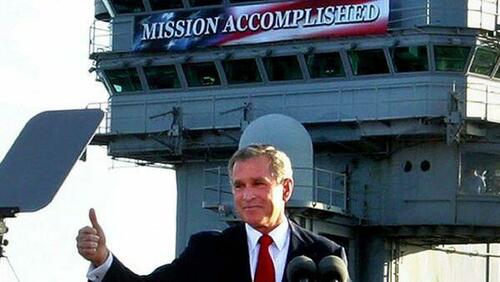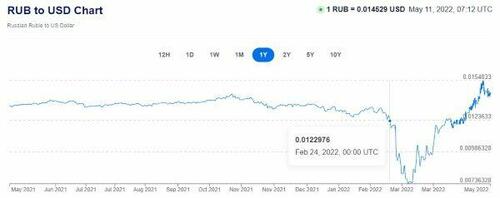This article was submitted by an external contributor and may not represent the views and opinions of Benzinga.
President Putin's Victory Day Speech
On Monday, Russia celebrated Victory Day, commemorating the defeat of Nazi Germany in World War II. Western observers watched President Putin's traditional speech with interest for clues about what might happen next in the war in Ukraine. You can watch his speech in full below, with English subtitles, but what was most notable about it was what he didn't say.
More on that below, but first let's note one positive takeaway from it:
This conciliatory gesture to Americans was a pleasant surprise, especially in light of last week’s leaks about U.S. intelligence being used to kill Russian generals and sink their Black Sea flagship. https://t.co/E6KdsuIzEO pic.twitter.com/V1gvWiJQyJ
— David Pinsen (@dpinsen) May 9, 2022
Broadly speaking, there were two popular theories about what Putin would say in this speech:
- He'd have a "Mission Accomplished" moment, like that of President George W. Bush on the aircraft carrier in 2003.

2. Putin would announce an escalation in Ukraine, including possibly a formal declaration of war or a mass mobilization in Russia to continue the war.
In the end, neither of those things happened. The subtext of the speech seemed to be that Putin thinks Russia is winning in Ukraine, and he's not in a particular hurry to wrap up the war. There's some evidence he might be right. Let's review.
Weathering The Economic War
As I wrote last month, the West may have underestimated the size and strength of the Russian economy in launching its economic war against it.
How the West may have underestimated Russia. Atoms versus bits; basic materials versus finance and services. $BTU $USO $CENX $GDXJ https://t.co/Nf2MATmFw9
— Portfolio Armor (@PortfolioArmor) April 11, 2022
Now, the Economist notes that Russia's economy is "back on its feet".
Russia appears to be keeping up with payments of its foreign-currency bonds. The real economy is surprisingly resilient too https://t.co/CmmKnDeOy8
— The Economist (@TheEconomist) May 9, 2022
One indicator of resiliency is the performance of the ruble since the invasion started: it's now up about 18% in dollar terms since February 24th.
After initially raising its key rate to 20% to support the ruble, Russia's central bank has since lowered its rate twice, to first to 17% and now to 14%--still high, but seemingly appropriate, given Russia's inflation rate of 16.7%. Having its key rate in the ballpark of its inflation rate is something the United States once did as well.
where we stand pic.twitter.com/zIpEJ5AzAJ
— zerohedge (@zerohedge) May 7, 2022
The Progress of The War In Ukraine
There is an actual war in Ukraine and an information war about what's happening there, so it can be hard to sort through propaganda from both sides to see what's actually happening. One thing to keep an eye out for is the military equivalent of a statement against interest. When Russia said its Black Sea flagship, the Mosvka, sunk, that was one such statement against interest. It does them no benefit to acknowledge a defeat like that, so we can assume it's likely true. Similarly, if a Western analyst says Ukraine may not be doing well militarily, we can assume that analyst is on the level as well, since the West is backing Ukraine in this war.
With that in mind, consider the comments by Colonel Markus Reisner of the Austrian military academy.
Markus Reisner, Austria's top military strategist: "Ukraine's situation is much worse than is believed in the West": "The bitter truth is: Putin can win the war"https://t.co/RTCxep6sCO
— Arnaud Bertrand (@RnaudBertrand) May 7, 2022
Colonel Reisner also posts weekly briefs on the war on YouTube. They're in German too, but by clicking on "settings" you can turn on English subtitles. In last week's video, he analogized the situation in the Donbas region of Ukraine to World War I trench warfare. The Russians are up against fortifications and trench systems that the Ukrainians have established over a period of years, so their progress has been very slow. But Russia has an advantage in artillery and airpower over Ukraine.
Russia isn't fighting the American army, and God willing they never will. However, American doctrine is the starting point for western militaries and Ukraine is operating at a similarly huge artillery disadvantage, but without the air superiority that America can count on. (14/N)
— Big Serge ��� (@witte_sergei) May 5, 2022
That advantage may be lessened by the enormous amount of Western (and in particular, American) aid being sent to Ukraine, but there are two points to bear in mind regarding that. The first is Colonel Reisner's comment about the amount of Western equipment that gets destroyed or captured by the Russians (so much has gotten captured that Russia has printed Russian instructions for some weapon systems like antitank rockets for its troops). The second is some of what's going on with these Western aid deliveries is the equivalent of "cleaning out the garage".
Inbox --> The Pentagon just distributed this rundown of U.S. military assistance provided to Ukraine: pic.twitter.com/qvKRA9ql2p
— Andrew deGrandpré (@adegrandpre) May 11, 2022
Consider that the U.S. is giving Ukraine 200 M113 armored personnel carriers. These are aluminum alloy-hulled, Vietnam-era vehicles that offer protection against rifle rounds and little else. The U.S. military announced plans several years ago to replace its M113s with the Armored Multi-Purpose Vehicle manufactured by BAE Systems, Plc BAESF; a cynic might wonder if dumping M113s off on Ukraine is a way of expediting that purchase order.
Weathering the War and Bear Market as Investors
Let's wrap this up by turning our focus to something actionable, what we can do with our own investments in light of the war and other gloomy news. In an article last week, I showed one approach using ProShares Ultra Bloomberg Natural Gas BOIL, Teucrium Wheat Fund WEAT, Direxion Daily Emerging Markets Bear 3x Shares EDZ, and ProShares UltraShort FTSE Europe EPV:
Let's say you have $50,000 to invest now, but you don't want to risk losing more than 20% in a worst case scenario. On Monday, our system might have presented this portfolio to you, which is essentially a hedged bet on natural gas and corn getting more expensive, and European and emerging market stocks getting cheaper over the next six months.
Screen capture via Portfolio Armor on 5/2/2022.
Here's an update on that portfolio has performed since May 2nd.
As you can see, it's up 0.52% since then, versus SPY which was down 3.71% over the same period.
© 2025 Benzinga.com. Benzinga does not provide investment advice. All rights reserved.
Trade confidently with insights and alerts from analyst ratings, free reports and breaking news that affects the stocks you care about.
